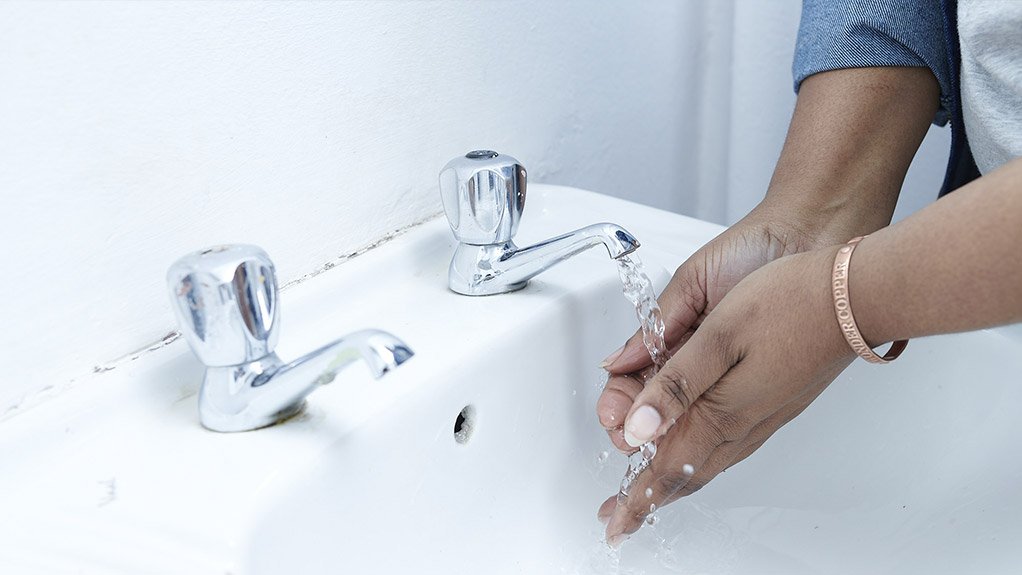Plumbing industry plays a central role in water demand management
This article has been supplied as a media statement and is not written by Creamer Media. It may be available only for a limited time on this website.
In less than 10 years, it is predicted that water demand will surpass supply in South Africa. The onus, therefore, also lies with households and businesses to use water efficiently to help avert this looming crisis. The implementation of efficient plumbing systems is a critical first step in the water-management hierarchy, which prioritises specific interventions to conserve water.
“Attending to leakages and installing water-efficient plumbing fixtures and fittings on properties are the easiest and most cost-effective of the three levels of the water-management hierarchy to implement. By first focusing on improving the efficiency of existing plumbing systems, some premises have been able to reduce water demand by more than 50%. This is before implementing the subsequent levels of the water-management hierarchy to further reduce reliance on municipal supplies. These levels include reusing or recycling water; outsourcing water through methods such as rainwater harvesting; and the regeneration or treatment of wastewater before it is reused,” Brendan Reynolds, Executive Director of the Institute of Plumbing South Africa (IOPSA) says.
IOPSA-accredited plumbers are trained to correctly repair leaking pipes and faulty plumbing systems, as well as install new water efficient fittings. This is in addition to the skills and experience that are needed in the subsequent levels of the water-management hierarchy. These include the ability to properly and safely plumb treated greywater and groundwater sources directly into buildings for specific applications. The association’s members have, therefore, worked with many of the country’s engineers on “greening” projects that have helped, among others, households, businesses, learning institutions and schools reduce reliance on severely strained municipal grids.
Among these water efficiency projects are those that were undertaken in Cape Town to help drive back “Day Zero”, when it was anticipated that the city would run out of water during the worst drought in the Western Cape in more than 100 years. While the situation has since normalised in the city, many areas of the province, including towns in the Great Karoo, are still experiencing severe water shortages due to the unrelenting dry spell.
There has also been a notable growth in demand for water efficient plumbing in other provinces, considering the large role that it plays in reducing municipal water services bills. This has helped to incentivise homeowners and businesses to use water more efficiently. It is believed that this trend will persist unabated as water costs continue to treble. Municipal water costs have been increasing four times faster than inflation and, in 2020, they were almost 1 300% higher than in 1996. These charges, including the basic water levy, currently account for the second-largest component of municipal bills after electricity. They make up
as much as between 28,2% and 17% of the municipal bill of low-income and high-income households, respectively.
Demand for efficient plumbing is also driving extensive innovation in plumbing systems by international manufacturers. For example, major strides have been made by companies in improving the efficiencies of toilets and flushing mechanisms. One such flush mechanism is able to save households about 5 000l of water a month and large premises that are occupied by many people, such as schools, as much as 16 000l of water a month. “Older toilets use between as much as 13l of water per flush and regular toilets now use around 6l per flush. Toilets remain the biggest user of water in homes. Flushing accounts for almost 30% of an average home’s indoor water consumption, hence the intense focus on this aspect of plumbing by many international manufacturers to help reduce water demand,” he says.
Another major innovation in the field of efficient plumbing is low-flow showerhead technology. These plumbing fixtures consume about 10l per minute compared to the 15l of water used a minute by conventional shower heads. They work by either restricting water flow and forcing it through very small apertures on the shower head or by mixing air into the flow. The latter, which is the most popular of the two types of low-flow showerheads, works similar to tap aerators. Although simple devices that can been easily installed, tap aerators make a marked impact on water consumption in households and property assets by reducing the flow of water from faucets.
Meanwhile, efficiency faucets are able to further reduce the amount of water used in bathroom and kitchen sinks. A conventional bathroom and kitchen faucet dispenses about 8,3l of water per minute compared to the 5,6l of water per minute from new water efficient taps.
A further benefit of these technologies is the role that they play in minimising wear and tear on pipes and fixtures by reducing flows – if correctly installed and maintained by qualified plumbers.
IOPSA continues to work closely with many of the country’s municipalities to promote the efficient use of water in their jurisdictions. This is by ensuring that homeowners and businesses always use the services of qualified plumbers to install, maintain and repair plumbing systems that have been certified by relevant quality standards authorities.
“The Department of Water and Sanitation has long recognised the role that plumbing plays in reducing water demand. It has, therefore, developed model water services bylaws to help municipalities ensure the efficient use of water in their jurisdictions. These model services bylaws are clear about the duties that may be undertaken by qualified plumbers. IOPSA is helping some municipalities implement these model water services bylaws to ensure the
highest standard of plumbing workmanship so that our precious water resources are used responsibly by constituents,” Reynolds concludes.
Comments
Announcements
What's On
Subscribe to improve your user experience...
Option 1 (equivalent of R125 a month):
Receive a weekly copy of Creamer Media's Engineering News & Mining Weekly magazine
(print copy for those in South Africa and e-magazine for those outside of South Africa)
Receive daily email newsletters
Access to full search results
Access archive of magazine back copies
Access to Projects in Progress
Access to ONE Research Report of your choice in PDF format
Option 2 (equivalent of R375 a month):
All benefits from Option 1
PLUS
Access to Creamer Media's Research Channel Africa for ALL Research Reports, in PDF format, on various industrial and mining sectors
including Electricity; Water; Energy Transition; Hydrogen; Roads, Rail and Ports; Coal; Gold; Platinum; Battery Metals; etc.
Already a subscriber?
Forgotten your password?
Receive weekly copy of Creamer Media's Engineering News & Mining Weekly magazine (print copy for those in South Africa and e-magazine for those outside of South Africa)
➕
Recieve daily email newsletters
➕
Access to full search results
➕
Access archive of magazine back copies
➕
Access to Projects in Progress
➕
Access to ONE Research Report of your choice in PDF format
RESEARCH CHANNEL AFRICA
R4500 (equivalent of R375 a month)
SUBSCRIBEAll benefits from Option 1
➕
Access to Creamer Media's Research Channel Africa for ALL Research Reports on various industrial and mining sectors, in PDF format, including on:
Electricity
➕
Water
➕
Energy Transition
➕
Hydrogen
➕
Roads, Rail and Ports
➕
Coal
➕
Gold
➕
Platinum
➕
Battery Metals
➕
etc.
Receive all benefits from Option 1 or Option 2 delivered to numerous people at your company
➕
Multiple User names and Passwords for simultaneous log-ins
➕
Intranet integration access to all in your organisation





















